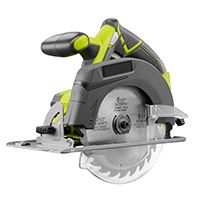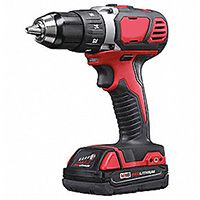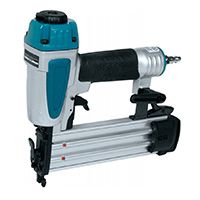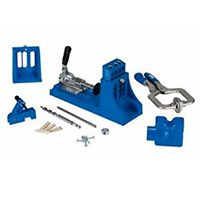We may be compensated if you purchase through links on our website. Our team is committed to delivering honest, objective, and independent reviews on home products and services.
A scrap wood storage holder can transform your cluttered garage or workshop into an efficient, organized space. Building one yourself is relatively easy with basic woodworking skills, so it’s suitable for both beginners and experienced DIYers. In the video above, Jenn Largesse from House One shows how to make a scrap wood storage holder that keeps your materials accessible and your work area tidy.
Tools and Materials Needed for a Scrap Wood Holder
Before you begin building, have the following materials and tools ready:
- 1 1/2-inch nails
- 1 1/4-inch pocket hole screws
- 3/4-inch plywood (one 4-by-8 sheet)
- 3/4-inch x 2′ x 4′ project panel (for the base)
- Circular saw or table saw
- Drill/driver
- Pencil for marking cuts
- Pneumatic nailer
- Pocket hole jig
- Tape measure
- Wood glue
Steps To Build Scrap Wood Storage
Follow the below steps to build a wood storage holder for scrap wood and small pieces of lumber.
Step 1: Cut the Plywood
The first step is cutting the plywood pieces to size. Use your circular saw or table saw to cut the following pieces:
- Base: 34 1/2 inches wide x 24 inches deep
- Back wall: 34 1/2 inches wide x 36 1/2 inches high
- Middle wall: 34 1/2 inches wide x 25 3/8 inches high
- Middle wall: 34 1/2 inches wide x 16 5/8 inches high
- Front wall: 34 1/2 inches wide x 8 3/4 inches high
- Sides: Two pieces at 25 1/2 inches wide x 36 1/2 inches high
- Optional dividers: Two pieces at 7 inches deep x 1 1/2 inches high
Step 2: Assemble the Base and Walls
With your plywood pieces cut to size, you can start assembling the storage unit. Follow these steps to build the base and attach the walls.
- Drill pocket holes: Drill pocket holes along the front and back edges of the base. These will connect the front and back walls to the base.
- Prepare middle walls: Drill pocket holes along the bottom edge of each middle wall to allow attachment to the base.
- Attach front wall: Apply wood glue to the front wall and attach it to the edge of the base using 1 1/4-inch pocket hole screws.
- Secure back wall: Repeat this process for the back wall, securing it to the back edge of the base with glue and screws.
- Position side walls: Apply glue to the side edges of the front and back walls and the base. Position the first side wall, ensuring the front and back walls are flush with its edges.
- Nail side walls: Secure the side wall using a pneumatic nailer and 1 1/2-inch nails.
- Repeat for the other side: Flip the assembly and repeat the process to attach the remaining side wall with glue and nails.
Step 3: Install the Middle Walls and Dividers
Now, you can install the middle walls and dividers, if you want them. These will create separate compartments for organizing different sizes of scrap wood. Here’s how Largesse completes this phase of the project:
- Stand it up: Stand the assembly upright.
- Glue and position the tallest wall: Apply glue to the side and bottom edges of the tallest remaining wall. Position the wall in place, adjusting it to stand plumb.
- Nail middle wall: Nail through the side walls and into each edge of the middle wall. Drive screws down through the pocket holes and into the base to secure the wall.
- Attach remaining middle wall: Repeat this process to attach the remaining middle wall.
- Install dividers: For the optional dividers, nail through the shortest wall and into the divider. If space is tight, you can drive a screw at an angle through the wall and into the back of the divider.
Adding Additional Features to Your Wood Holder
Adding features can make your scrap wood holder more organized and functional. Here are some of our ideas:
- Caster wheels: Putting caster wheels on the base of your storage unit will make it mobile. This is handy if you need to move your storage unit around your workshop frequently. Use heavy-duty caster wheels that can support the weight of the plywood and stored wood.
- Adjustable shelves: Incorporate adjustable shelves into the middle section of your storage unit. This will allow you to store various lengths of wood and offcuts. Re-position the shelves as needed to accommodate changing storage requirements.
- Hooks and pegs: Install hooks and pegs on the sides of your storage unit to hold smaller tools and accessories. This will keep your workspace organized and tools readily available.
Finishing Touches and Organization Tips for a Wood Holder
After assembly, you can put the finishing touches on your project and start organizing your workshop. Consider these tips:
- For a smooth finish, sand any rough edges or surfaces to prevent splinters.
- To protect the plywood and enhance its appearance, apply a coat of paint or wood sealer.
- Label each compartment to indicate the size or type of scrap wood it should contain.
- To make finding the right piece easier, sort your scrap wood by length, width, or wood type.
- Store longer pieces vertically in the taller compartments and shorter pieces horizontally in the lower sections.
- Regularly purge your scrap wood collection, discarding pieces that are too small to be useful or have become damaged.




